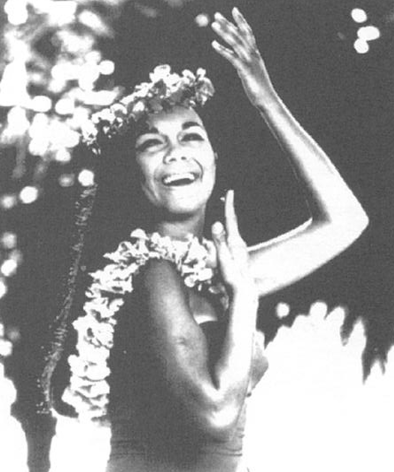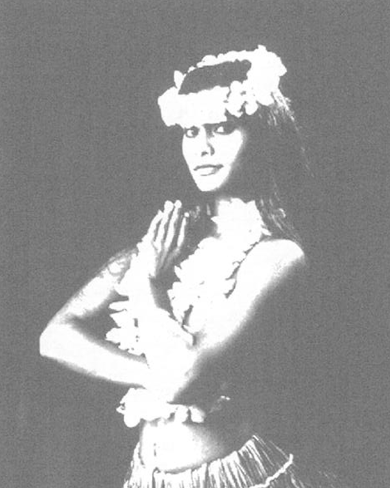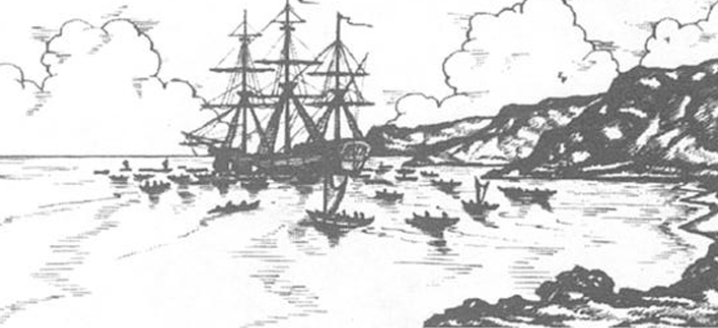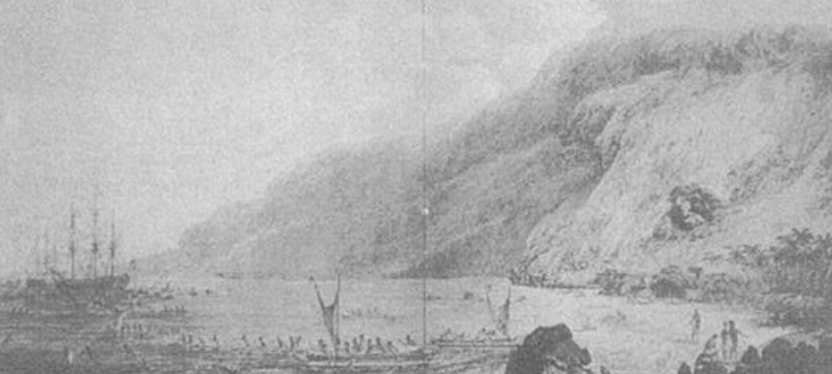by Isabella Soluri
History is often told from the perspective of the winners, centering their stories and points of view over those of oppressed minority populations. Viewing subaltern history from the perspective of the subaltern themselves, reveals different avenues for understanding historical events and forces us to question why we are taught certain versions of history. Focusing on Native Hawaiians and the murder of Captain James Cook, I will craft a retelling of this violent event from below, focusing on Native perspectives and subaltern cultural impacts. Further, I will call upon different postcolonial theorists, such as Fanon, Chakrabarty, and Escobar, to discuss ideas of necessary violence, the agency of supernatural beings within a decolonial context, and a plurality of realities in a postcolonial world. The following reimagining of Captain Cook’s murder will give agency to Native Hawaiian gods and reveal how his murder and the accompanying violence were necessary for decolonization and upholding the Native community’s values.
Background of Captain Cook’s Murder
Captain James Cook was murdered by Native Hawaiians on February 14, 1779, on his third and final voyage to the Hawaiian Islands. However, the brutal death of the explorer, and general violence from the Native Hawaiians, were not characteristic of his previous expeditions and encounters in Hawaii. During his first interactions with the Native Hawaiians, Cook was welcomed and celebrated at the Kealakekua Bay, a bay known to be a sacred harbor of a Hawaiian fertility god, Lono. Given the cultural significance of the bay itself and Cook’s arrival during a celebratory festival for Lono, many historians believe that the Native Hawaiians came to view Captain Cook as Lono, the fertility god (“Captain Cook Killed in Hawaii”). Yet, Cook’s deification did not save him from his ultimate death. After bringing deadly infectious diseases to the Hawaiians and attempting to kidnap the ruling chief at the time, Kalaniʻōpuʻu, the Native Hawaiians turned to violence, killing Captain Cook, and scaring off the rest of his crew.
Parallels With Dipesh Chakrabarty: Agential Thakur and Lono
The language utilized when writing history is deeply impactful, and that is apparent in the way the Native Hawaiians’ religious and cultural importance of Cook in relation to Lono is so often talked about. Usually, their view of Cook as Lono is referred to as a belief or a supernatural idea they came up with, rather than something that holds any truth. One can see correlations between Chakrabarty’s telling of the Santal Rebellion and the god Thakur’s role in the rebellion. Chakrabarty explains how the Santals expressed absolute agency to their god Thakur as their reasoning for the uprising, stating they turned to violence because Thakur told them to do so (Chakrabarty 2002). He further explains that anthropologists cannot fully give Thakur agency because even when attempting to do so, “the historian, as historian and unlike the Santal, cannot invoke the supernatural in explaining/describing an event” because they have inherently converted the supernatural being into a belief or object of analysis (Chakrabarty 2002: 235). This dilemma that Chakrabarty introduces can further be applied to the case of Captain Cook and the Native Hawaiians. Historians or anthropologists must determine how to give agency to the god Lono, as the Native Hawaiians did, without discounting this agency as a mere belief of a subaltern history or a simple piece of evidence.
Chakrabarty presents a particular solution to this historicizing dilemma that can help prevent anthropologists or historians from maintaining a hierarchical, subject-object relationship with subaltern pasts and histories. Regarding the Santal Rebellion, he proposes that when the Santal gives Thakur agency, as historians, “we could ask ourselves: Is that way of being a possibility for our own lives and for what we define as our present?” (Chakrabarty 2002: 237). Connecting back to the Native Hawaiians, I propose a parallel view of agency with Lono, the Native’s god of fertility, acting through Captain Cook. In doing so, one can then question what this god’s agency can mean for the present, or as Chakrabarty says, can this agency “help us to understand a principle by which we also live in certain instances?” (Chakrabarty 2002: 237). While there are minimal records from the Native Hawaiians themselves, and their beliefs of Captain Cook, based on the historical accounts we have about the importance of their god Lono and his connection to the arrival of Cook, one can infer the Hawaiians awarded agency to their god, Lono. Even with minimal records, some accounts of Hawaiians deifying Captain Cook still exist. Historian Samuel Kamakau notes, “The men hurried to the ship to see the god with their own eyes” concerning the Hawaiians and Cook (Subin 2021). This perspective further makes us, as anthropologists, question the Native’s decision to murder Captain Cook. In conjunction with the documentation of diseases brought over by Cook, and the anger and destruction he brought while in Hawaii, when giving agency to Lono, one can see how impactful the choice to kill him was for the Hawaiians.
The murder of Cook occurred after he attempted to capture their chief ruler at the time, which inherently speaks to the respect that the Native Hawaiians held at the time for those in powerful positions. These values become even more powerful when you consider the person they murdered was seen as the reincarnation of their god. Questioning how the values of the Native Hawaiians, emphasized after giving Lono agency, could impact our present lives, thus allows us as anthropologists to refuse to historicize the Native Hawaiians. Instead, though, seeing them as “a figure illuminating a life possibility for the present” and a chance to “put us in touch with the plural ways of being that make up our own present” (Chakrabarty 2002: 237). If discussing the agency of Lono and other supernatural beings is done in a way that resists the hierarchical system that is often maintained through historicizing subaltern pasts, we can instead be introduced to how other life figures can impact our own lives in the present. It is essential to question how agential supernatural beings, like gods, of different cultures can influence our own present lives, rather than historicize these figures in a way that discounts their agency.
Parallels With Fanon: Necessity of Violence for Decoloniality
The murder of Captain Cook can also be reimagined through a lens that centers on the necessity of violence in decolonial struggles, a fundamental tenet of Frantz Fanon’s postcolonial theory. Before analyzing the violence that the colonized subject uses, one must first understand the violence forced upon them by the colonizer. Fanon explains how the colonizer, in this case, Captain Cook, forces extreme levels of violence, bringing it “into the homes and minds of the colonized subject,” the Native Hawaiians (Fanon 1963: 4). This violence from Captain Cook is documented in various historical accounts, with an especially gruesome account revealing that he “flogged [the Natives] mercilessly for trivial thefts, or cut their ears off” (Morris 1979). This account of Cook and his crew’s violence does not stand alone. It is often compounded with documentation of him bringing deadly diseases to the Hawaiian Islands, causing irreparable harm to the Native communities. This violence is characteristic of a colonizer/colonized relationship, according to Fanon and other postcolonial theorists, and it sets the groundwork for why violence, turned against the colonizer, is necessary for decolonial efforts.
Taking the extreme violence forced upon the Native Hawaiians at the hands of Captain Cook, it connects to what Fanon refers to as atmospheric violence (Fanon 1963). The colonized individuals, the Native Hawaiians, have faced such high levels of violence that it is atmospheric, or “rippling under the skin,” and results in them casting their “exacerbated hatred and rage” in the direction of the colonizer (Fanon 1963: 32). Colonized individuals end up embodying this violence they are forced to endure, and the violence stored within their body becomes the only route to completely break down this hierarchical system in which the colonist is protected. Thus, the violence, torture, and disease that Captain Cook forced upon the Hawaiians became the tool with which the Hawaiians themselves tore down this subject-object hierarchical system.
Connections Between Chakrabarty and Fanon in the Case of Captain Cook
If we give Lono agency the same way the Hawaiians likely did and understand that Cook was acting through Lono, or was Lono himself, it allows present anthropologists to understand the violence and motivation behind that violence differently. Instead of simply revolting against someone trying to capture their ruler, they were rebelling against their own God. Utilizing violence against a religious figure they respected and valued reveals entrenched levels of respect and admiration they held for the chief ruler. This viewpoint, though, also further demonstrates the necessity of violence in decolonial struggles. Fanon describes how during decolonial efforts, colonized groups are forced to turn their backs on their religious rituals or cultural stories and beliefs. He explains this concept more explicitly in the excerpt below:
During the struggle for liberation there is a singular loss of interest in these rituals. With his back to the wall, the knife at his throat, or to be more exact the electrode on his genitals, the colonized subject is bound to stop telling stories (Fanon 1963: 20).
One could argue that is what occurred with the Native Hawaiians when they turned to violence against Captain Cook, and according to history, no longer ‘believed’ Cook to be their god, Lono. Based on his theories, I argue that even Fanon would agree with this, in how he describes that the colonized subject “discovers reality and transforms it,” resulting in a violent decolonial agenda (Fanon 1963: 21). However, it is here that we once again come to a dilemma when referring to the agency of supernatural beings. How can we give agency to Lono but then go on to disregard it when it comes to violence? Claiming Hawaiians found ‘reality’ and killed Captain Cook because of this discovery? How can we assume that they did not already exist within their own parallel reality? Making these assumptions would then inherently discount Lono as an agential being.
Framing it in a manner that claims the Hawaiians, or colonized subjects in general, ‘discover reality’ and then had no choice but to turn to violence, condescends the worldview of the subaltern. The violence can be just as necessary, if not more, when we accept Lono’s parallel reality or world as an agential being, acting through Captain Cook. With this view, we can still utilize Fanon’s idea of atmospheric violence, and the embodiment of violence within colonized subjects, without disregarding the reality of their Gods as agents in their lives. Thus, the colonial forms of violence forced upon them was done so at the hands of their own god, through Captain Cook, and it is this level of ultimate betrayal from Lono that forced them to utilize violence. From this choice of violence, after the betrayal of their God, one can learn about the values of this cultural group. The ability to organize on a mass level, the collective action inherently associated with successfully murdering Captain Cook, and the active choice to rebel against a reincarnation of their god, speak to the resilience of Native Hawaiians and how vital community is to their culture. Thus, we can then return to Chakrabarty as well and question as anthropologists how this reality and Lono as an agential being could impact our own reality, and even our own individual lives. Does it make us question why we do not view Western gods as agential beings? Are we forced to question the values that reflect our own religions, compared to those of Native Hawaiians that are reflected with Lono acting with agency? One might argue that the Western majority already sees their Christian God as an agential being, but can our current society organize levels of collective action and display the kinds of community appreciation seen in the Native Hawaiians? These questions and deliberation can help break down the problem associated with historicizing a subaltern history, inherently othering it. Comparing cultures and questioning Western norms compared to realities of subaltern pasts can help dismantle the myth of Western modernity and progress. Instead, it can rather promote a plurality of culture and even a plurality of realities.
The Ontological Turn and Arturo Escobar’s Pluriverse
With these theoretical approaches in mind, one can then relate these ideas of Native Hawaiians and agential gods to the concept of the ontological turn and Arturo Escobar’s vision of the pluriverse. Escobar roughly defines his concept of the pluriverse as “a world where many worlds fit” and where “the rising concepts and struggles from and in defense of the pluriverse constitute…a practice of interbeing” (Escobar 2011: 139). He opens the idea for multiple realities, perhaps where some cultures have gods with agency, and others do not. The pluriverse welcomes humans, animals, non-humans, and the supernatural, and proposes a hopeful path forward for building community and breaking down hierarchical structures that allow Western ideas to dominate and subvert cultures that do not coincide with their own. Escobar’s pluriverse shares many similarities with the anthropological concept of the ontological turn. Anthropologists loosely define the ontological turn as a viewpoint that “proposes…openness to difference of all kinds, be it what we would call cultural and epistemological or natural, and indeed, ontological” (Heywood 2021). Both the ontological turn and the pluriverse embrace difference, and even encourage it, and they offer a collaborative, community-focused path forward in a postcolonial world.
However, this idea of the ontological turn, and to an extent, the pluriverse, while welcoming difference and the plurality of thought, has shortcomings when put into practice. Zoe Todd both defines and critiques the ontological turn in the excerpt below.
The Ontological Turn – with its breathless ‘realisations’ that animals, the climate, water, ‘atmospheres’ and non-human presences like ancestors and spirits are sentient and possess agency, that ‘nature’ and ‘culture’, ‘human’ and ‘animal’ maybe not be so separate after all – is itself perpetuating the exploitation of Indigenous peoples (Todd 2016).
Todd goes on to explain how the main critique of the ontological turn within the discipline is the silences that tend to accompany it (Todd 2016). We cannot discuss the agency of Lono, Thakur, or any other supernatural beings, or delve into ideas of the pluriverse and plural realities and accepting difference without admitting to the colonialism that still runs rampant in the academy and society overall. The ontological turn runs the risk of disregarding current colonialism and “erasing the embodied, practice, and legal-governance aspect of Indigenous ontologies as they are enacted by Indigenous actors” (Todd 2016). My own theoretical discussions above regarding Native Hawaiians, Lono, and agential supernatural beings would not be complete, and would lose credibility, without the above critiques of the argument I am making.
Even with good intentions of accepting differences, these turns within anthropology hold no weight without concrete action following them. I cannot comfortably discuss theoretical takes of multiple realities and worldviews as coexisting peacefully and cannot call upon the ontological turn regarding 18th century Hawaii gods and rebellions, if I then fail to address the current colonial trends that still perpetuate within Hawaii. Tourism acting as a neocolonial system, the exoticism of Hawaiian Natives, and false narratives of the ‘welcoming Hawaiian’ that help perpetuate tourism are all examples of recursive themes of colonialism. With Todd’s critiques in mind, I further urge proponents of the ontological turn to give space to Indigenous voices internationally within the discipline and in the academy’s syllabi. Only in doing so and confronting the current harm caused by colonialism in Indigenous communities, can we then attempt to discuss a world of community and pluriverse.
Ideas for a Path Forward
Without disregarding the above critiques of the ontological turn and keeping current colonial systems in mind, I argue the pluriverse is still a hopeful path forward into a postcolonial world. Escobar’s arguments of treating other realities and worlds as equals, and emphasizing community and togetherness are optimistic avenues of change. The Native Hawaiians and Lono can exemplify these theoretical ideas, revealing how multiple realities and forms of being can exist within one world. Accepting Lono’s agency also allows us to push Fanon’s view of violence further. Revealing how the colonized do not have to turn their backs on their rituals and gods to utilize violence, but instead how violence can become an even more powerful choice when agential beings are involved. These theoretical approaches to the murder of Captain Cook give us opportunities to envision the pluriverse as Escobar describes it, and a chance to deepen our understanding of plural realities and the potential within them.
Bibliography
“Captain Cook Killed in Hawaii.” History.com A&E Television Networks, February 10, 2021. https://www.history.com/this-day-in-history/captain-cook-killed-in-hawaii
Chakrabarty, Dipesh. 2002. “Minority Histories, Subaltern Pasts” in Postcolonial Passages. Oxford: Oxford University Press, 229-242.
Escobar, Arturo. 2011. Sustainability: Design for the Pluriverse. Development, 137-140.
Fanon, Frantz. 1963. “On Violence.” In The Wretched of the Earth. New York: Grove Press, 1-62.
Heywood, Paolo. 2021. “Ontological Turn, The.” Open Encyclopedia of Anthropology. https://www.anthroencyclopedia.com/entry/ontological-turn
Morris, Jan. 1979. “The Murder of Captain James Cook Richard Hough (Book Review).” The Spectator, Retrieved April 14, 2021.
Subin, Anna Della. “How Do You Kill a God?” Literary Hub, November 29, 2021. https://lithub.com/how-do-you-kill-a-god-on-captain-cooks-ill-fated-arrival-in-hawaii/
Todd, Zoe. 2016. An Indigenous Feminist’s Take on the Ontological Turn: ‘Ontology’ Is Just Another Word for Colonialism. Journal of Historical Sociology, 29: 4-22. doi: 10.1111/johs.12124.



